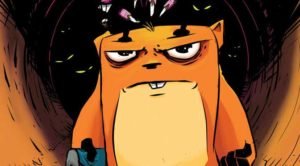Writer: David Galiano
Artist: Carlos Angeli
Mad Cave Comics, January 2020
The appeal of the Western genre is sometimes lost upon people who live outside of the United States. Traditional Westerns tend to romanticise the colonial creep of lawless Europeans across the North American continent. In 1878, when this story, Savage Bastards, is set, in Paris the third Exposition Universelle (Paris World Fair) attracted 13 million people from around the world. In Japan, 1878 marked the final stages of the opening of the country to foreigners, such that for the first time in recorded history people from outside Japan could explore what had been a mysterious and violent country – including famous explorer Isabella Bird, who accomplished the feat on horseback and wrote of it in 1878. In London, Alexander Graham Bell demonstrated the telephone to Queen Victoria. Why, with all of these marvels, bother to idealise a bleak session of history in a rugged and inhospitable part of the world?
Savage Bastards tackles the lawless terror of 1878’s Old West with a mugger’s embrace. Writer David Galiano pulls no punches with his introduction to the antagonists. Cornered in Guanajuato, Mexico, is a black gunfighter named Rose Franklin. She manages to shoot dead some of her assailants but is eventually captured and tortured by a man called The Spider and his cohort.

When she spits her own blood in his face, he furiously kills her. This start of the story pulls no punches. Rose is first seen wandering through Guanajuato eating a plum, with the panel close up to her lips and the sensual activity of eating something juicy – a corporeal experience, personal yet commonplace, an indicia of life. Rose’s death, a few pages later, a cooling body slumped while tied to a tree, is a thumping juxtaposition.
The scene cuts to a character named Elliot Wright, the dandy barber and frustrated writer, who boards with an unseen woman named Mrs Brendel. Elliot is a man plainly out of place: lost in daydreams, idly cutting hair, where the worst of his acts is to be caught having an erotic dream with a married woman. Blonde with green eyes, more pretty than handsome, Elliot, it evolves, is the son of a woman called Jessica and a man named Darraugh McDougall.
In McDougall we have the villain of the piece, and Mr Galiano and artist Carlos Angeli laden imagery and metaphor to communicate to the reader that McDougall is not just vile, but is legendarily evil. McDougall lives in a tall red structure called the Tower of Eternity in the Center of the Red Sands, Sonora Desert, Arizona. It is a fortress overlooking a sandy courtyard surrounded by a wall, all sitting in landscape, which Mr Angeli is at pains to render as hellish and hostile. McDougall himself is not bothered by his boiling surrounds: the Tower is filled with Persian carpets, handcrafted woodwork, and books (the devil is not just the father of lies but is a sophisticate, the keeper of knowledge). Only the denizens of Hell suffer from its heat, after all, not the devil. And the devil is lustful: he keeps concubines, and he is surrounded by children and breeds like Zeus. McDougall’s allies are his children; his targets are his children; his right hand man, Black Bart, is his son. On the outskirts of the kingdom are dusty towns, breeding outposts which allow McDougall to sow his seed further and create additional servants.

A character called Samuel
Franklin appears in the story, and Mr Angeli does this very well – Samuel
appears out of the corner of both Elliot’s and the reader’s eye (we had to go
back and look for him in the panel where he is first introduced). Samuel is
black, with startling green eyes, extremely well educated, good in a fight, and
with a temper. This is another one of McDougall’s sons and Rose was his mother.
Samuel has come to intervene as McDougall’s men try to gather up Elliot.
Violence follows.
Mr Galiano has done an
excellent job on this story, but Mr Angeli is the one who wins the prizes. As
we noted above, the art is loaded with clever imagery. The most striking of
these is one of chickens flapping in an alley as The Spider’s henchman tells
his posse off for being useless in their efforts to capture Rose. This title is
exciting, clever, and full of promise.

